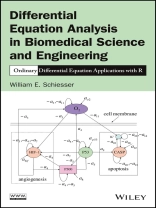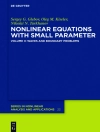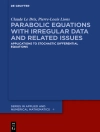Features a solid foundation of mathematical and computational
tools to formulate and solve real-world ODE problems across various
fields
With a step-by-step approach to solving ordinary differential
equations (ODEs), Differential Equation Analysis in Biomedical
Science and Engineering: Ordinary Differential Equation
Applications with R successfully applies computational
techniques for solving real-world ODE problems that are found in a
variety of fields, including chemistry, physics, biology, and
physiology. The book provides readers with the necessary knowledge
to reproduce and extend the computed numerical solutions and is a
valuable resource for dealing with a broad class of linear and
nonlinear ordinary differential equations.
The author’s primary focus is on models expressed as
systems of ODEs, which generally result by neglecting spatial
effects so that the ODE dependent variables are uniform in space.
Therefore, time is the independent variable in most applications of
ODE systems. As such, the book emphasizes details of the numerical
algorithms and how the solutions were computed. Featuring
computer-based mathematical models for solving real-world problems
in the biological and biomedical sciences and engineering, the book
also includes:
* R routines to facilitate the immediate use of computation for
solving differential equation problems without having to first
learn the basic concepts of numerical analysis and programming for
ODEs
* Models as systems of ODEs with explanations of the associated
chemistry, physics, biology, and physiology as well as the
algebraic equations used to calculate intermediate variables
* Numerical solutions of the presented model equations with a
discussion of the important features of the solutions
* Aspects of general ODE computation through various
biomolecular science and engineering applications
Differential Equation Analysis in Biomedical Science and
Engineering: Ordinary Differential Equation Applications with R
is an excellent reference for researchers, scientists, clinicians,
medical researchers, engineers, statisticians, epidemiologists, and
pharmacokineticists who are interested in both clinical
applications and interpretation of experimental data with
mathematical models in order to efficiently solve the associated
differential equations. The book is also useful as a textbook for
graduate-level courses in mathematics, biomedical science and
engineering, biology, biophysics, biochemistry, medicine, and
engineering.
Spis treści
Preface ix
1. Introduction to Ordinary Differential Equation Analysis: Bioreactor Dynamics 1
2. Diabetes Glucose Tolerance Test 79
3. Apoptosis 145
4. Dynamic Neuron Model 191
5. Stem Cell Differentiation 217
6. Acetylcholine Neurocycle 241
7. Tuberculosis with Differential Infectivity 321
8. Corneal Curvature 337
Appendix A1: Stiff ODE Integration 375
Index 417
O autorze
WILLIAM E. SCHIESSER, Ph D, Sc D (hon.) is Emeritus Mc Cann
Professor of Engineering and Professor of Mathematics at Lehigh
University. The author or coauthor of thirteen books, Dr.
Schiesser’s research interests include numerical software;
ordinary, differential algebraic, and partial differential
equations; and computational mathematics.












